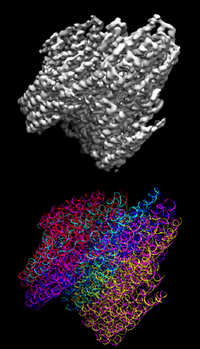
Photo from wikipedia
Nanosized artificial antigen-presenting cells (aAPCs) with efficient signal presentation hold great promise for in vivo adoptive cell therapy. Here, we used DNA origami nanostructures as two-dimensional scaffolds to regulate the… Click to show full abstract
Nanosized artificial antigen-presenting cells (aAPCs) with efficient signal presentation hold great promise for in vivo adoptive cell therapy. Here, we used DNA origami nanostructures as two-dimensional scaffolds to regulate the spatial presentation of activating ligands at nanoscale to construct high-effective aAPCs. The DNA origami-based aAPC comprises costimulatory ligands anti-CD28 antibody anchored at three vertices and T cell receptor (TCR) ligands peptide-major histocompatibility complex (pMHC) anchored at three edges with varying density. The DNA origami scaffold enables quantitative analysis of ligand-receptor interactions in T cell activation at the single-particle, single-molecule resolution. The pMHC-TCR-binding dwell time is increased from 9.9 to 12.1 s with increasing pMHC density, driving functional T cell responses. In addition, both in vitro and in vivo assays demonstrate that the optimized DNA origami-based aAPCs show effective tumor growth inhibiting capability in adoptive immunotherapy. These results provide important insights into the rational design of molecular vaccines for cancer immunotherapy.
Journal Title: Science advances
Year Published: 2022
Link to full text (if available)
Share on Social Media: Sign Up to like & get
recommendations!